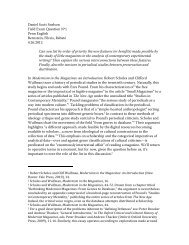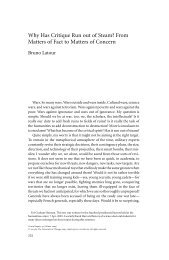The Exploit: A Theory of Networks - asounder
The Exploit: A Theory of Networks - asounder
The Exploit: A Theory of Networks - asounder
You also want an ePaper? Increase the reach of your titles
YUMPU automatically turns print PDFs into web optimized ePapers that Google loves.
32 Nodes<br />
graph where the size far exceeds the order. What can we tell by both<br />
the order and size <strong>of</strong> a graph? One <strong>of</strong> the basic theorems <strong>of</strong> graph theory<br />
states that for any graph with a finite number <strong>of</strong> edges, the sum <strong>of</strong><br />
the degrees <strong>of</strong> the nodes equals twice the number <strong>of</strong> edges. That is, if<br />
the degree <strong>of</strong> any node is the number <strong>of</strong> edges connected to it (for<br />
node n 1 with two edges connected to it, its degree 2), the sum <strong>of</strong><br />
all the degrees <strong>of</strong> the graph will be double the size <strong>of</strong> the graph (the<br />
number <strong>of</strong> edges). For a square, the sum <strong>of</strong> the degrees is 8 (the nodes<br />
[the square’s corners] each have 2 edges [the square’s lines] connected<br />
to them), while the sum <strong>of</strong> the edges is 4. In other words, the connectivity<br />
<strong>of</strong> a graph or network is a value different from a mere count <strong>of</strong><br />
the number <strong>of</strong> edges. A graph not only has edges between nodes but<br />
also has edges connecting nodes.<br />
From a graph theory perspective, networks can be said to display three<br />
basic characteristics: their organization into nodes and edges (dots and lines),<br />
their connectivity, and their topology. <strong>The</strong> same sets <strong>of</strong> entities can result<br />
in a centralized, rigidly organized network or in a distributed, highly flex -<br />
ible network.<br />
<strong>The</strong> institutional, economic, and technical development <strong>of</strong> the<br />
Internet is an instructive case in point. While the implementation <strong>of</strong><br />
packet - switching technology in the U.S. Department <strong>of</strong> Defense’s<br />
ARPANET ostensibly served the aims <strong>of</strong> military research and security,<br />
that network also developed as a substantial economic network,<br />
as well. Paul Baran, one <strong>of</strong> the developers <strong>of</strong> packet switching, uses<br />
basic graph theory principles to show how, given the same set <strong>of</strong> nodes<br />
or points, and a different set <strong>of</strong> edges or lines, one gets three very different<br />
network topologies. 6 <strong>The</strong> familiar distinction between centralized,<br />
decentralized, and distributed networks can be found everywhere<br />
today, not only within computer and information technologies but<br />
also in social, political, economic, and biological networks.<br />
As we have suggested, networks come in all shapes and flavors,<br />
but common types include centralized networks (pyramidal, hier -<br />
archical schemes), decentralized networks (a core “backbone” <strong>of</strong> hubs<br />
each with radiating peripheries), and distributed networks (a collection<br />
<strong>of</strong> node - to - node relations with no backbone or center).









